Weizhe Lin
TrimR: Verifier-based Training-Free Thinking Compression for Efficient Test-Time Scaling
May 22, 2025Abstract:Large Reasoning Models (LRMs) demonstrate exceptional capability in tackling complex mathematical, logical, and coding tasks by leveraging extended Chain-of-Thought (CoT) reasoning. Test-time scaling methods, such as prolonging CoT with explicit token-level exploration, can push LRMs' accuracy boundaries, but they incur significant decoding overhead. A key inefficiency source is LRMs often generate redundant thinking CoTs, which demonstrate clear structured overthinking and underthinking patterns. Inspired by human cognitive reasoning processes and numerical optimization theories, we propose TrimR, a verifier-based, training-free, efficient framework for dynamic CoT compression to trim reasoning and enhance test-time scaling, explicitly tailored for production-level deployment. Our method employs a lightweight, pretrained, instruction-tuned verifier to detect and truncate redundant intermediate thoughts of LRMs without any LRM or verifier fine-tuning. We present both the core algorithm and asynchronous online system engineered for high-throughput industrial applications. Empirical evaluations on Ascend NPUs and vLLM show that our framework delivers substantial gains in inference efficiency under large-batch workloads. In particular, on the four MATH500, AIME24, AIME25, and GPQA benchmarks, the reasoning runtime of Pangu-R-38B, QwQ-32B, and DeepSeek-R1-Distill-Qwen-32B is improved by up to 70% with negligible impact on accuracy.
Improved Fine-Tuning of Large Multimodal Models for Hateful Meme Detection
Feb 18, 2025Abstract:Hateful memes have become a significant concern on the Internet, necessitating robust automated detection systems. While large multimodal models have shown strong generalization across various tasks, they exhibit poor generalization to hateful meme detection due to the dynamic nature of memes tied to emerging social trends and breaking news. Recent work further highlights the limitations of conventional supervised fine-tuning for large multimodal models in this context. To address these challenges, we propose Large Multimodal Model Retrieval-Guided Contrastive Learning (LMM-RGCL), a novel two-stage fine-tuning framework designed to improve both in-domain accuracy and cross-domain generalization. Experimental results on six widely used meme classification datasets demonstrate that LMM-RGCL achieves state-of-the-art performance, outperforming agent-based systems such as VPD-PALI-X-55B. Furthermore, our method effectively generalizes to out-of-domain memes under low-resource settings, surpassing models like GPT-4o.
CULTURE3D: Cultural Landmarks and Terrain Dataset for 3D Applications
Jan 12, 2025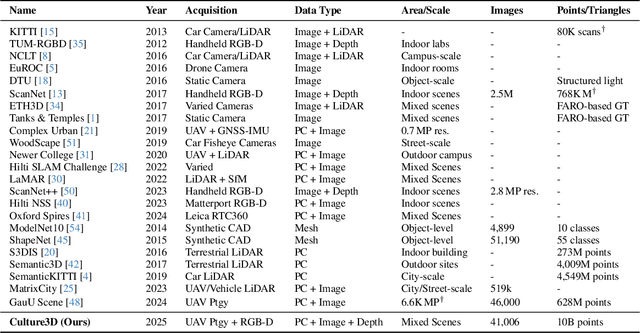
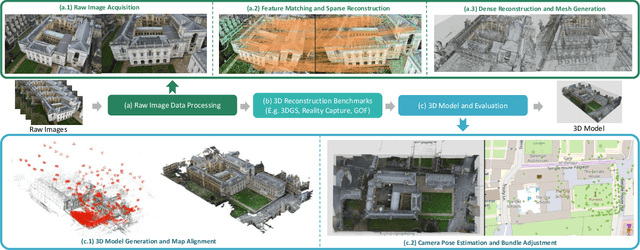
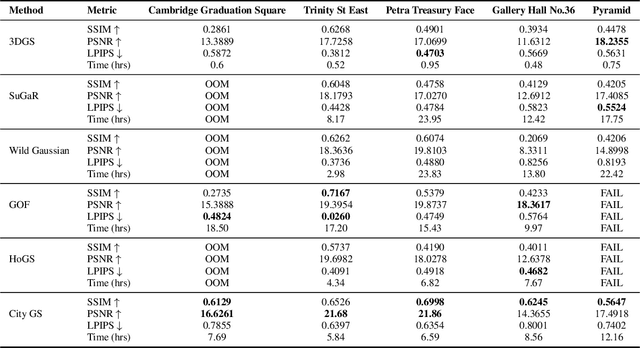
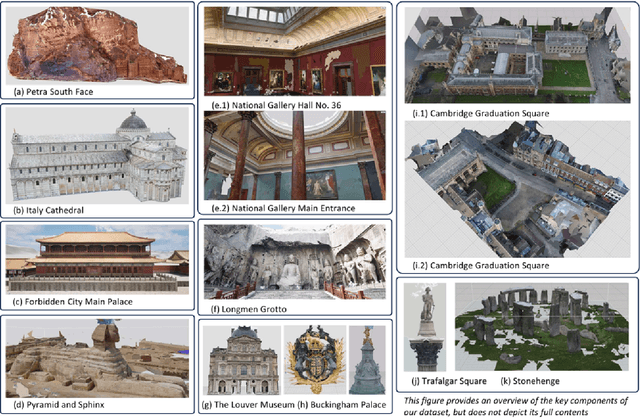
Abstract:In this paper, we present a large-scale fine-grained dataset using high-resolution images captured from locations worldwide. Compared to existing datasets, our dataset offers a significantly larger size and includes a higher level of detail, making it uniquely suited for fine-grained 3D applications. Notably, our dataset is built using drone-captured aerial imagery, which provides a more accurate perspective for capturing real-world site layouts and architectural structures. By reconstructing environments with these detailed images, our dataset supports applications such as the COLMAP format for Gaussian Splatting and the Structure-from-Motion (SfM) method. It is compatible with widely-used techniques including SLAM, Multi-View Stereo, and Neural Radiance Fields (NeRF), enabling accurate 3D reconstructions and point clouds. This makes it a benchmark for reconstruction and segmentation tasks. The dataset enables seamless integration with multi-modal data, supporting a range of 3D applications, from architectural reconstruction to virtual tourism. Its flexibility promotes innovation, facilitating breakthroughs in 3D modeling and analysis.
X-LeBench: A Benchmark for Extremely Long Egocentric Video Understanding
Jan 12, 2025Abstract:Long-form egocentric video understanding provides rich contextual information and unique insights into long-term human behaviors, holding significant potential for applications in embodied intelligence, long-term activity analysis, and personalized assistive technologies. However, existing benchmark datasets primarily focus on single, short-duration videos or moderately long videos up to dozens of minutes, leaving a substantial gap in evaluating extensive, ultra-long egocentric video recordings. To address this, we introduce X-LeBench, a novel benchmark dataset specifically crafted for evaluating tasks on extremely long egocentric video recordings. Leveraging the advanced text processing capabilities of large language models (LLMs), X-LeBench develops a life-logging simulation pipeline that produces realistic, coherent daily plans aligned with real-world video data. This approach enables the flexible integration of synthetic daily plans with real-world footage from Ego4D-a massive-scale egocentric video dataset covers a wide range of daily life scenarios-resulting in 432 simulated video life logs that mirror realistic daily activities in contextually rich scenarios. The video life-log durations span from 23 minutes to 16.4 hours. The evaluation of several baseline systems and multimodal large language models (MLLMs) reveals their poor performance across the board, highlighting the inherent challenges of long-form egocentric video understanding and underscoring the need for more advanced models.
Lucia: A Temporal Computing Platform for Contextual Intelligence
Nov 19, 2024Abstract:The rapid evolution of artificial intelligence, especially through multi-modal large language models, has redefined user interactions, enabling responses that are contextually rich and human-like. As AI becomes an integral part of daily life, a new frontier has emerged: developing systems that not only understand spatial and sensory data but also interpret temporal contexts to build long-term, personalized memories. This report introduces Lucia, an open-source Temporal Computing Platform designed to enhance human cognition by capturing and utilizing continuous contextual memory. Lucia introduces a lightweight, wearable device that excels in both comfort and real-time data accessibility, distinguishing itself from existing devices that typically prioritize either wearability or perceptual capabilities alone. By recording and interpreting daily activities over time, Lucia enables users to access a robust temporal memory, enhancing cognitive processes such as decision-making and memory recall.
Human-inspired Perspectives: A Survey on AI Long-term Memory
Nov 01, 2024


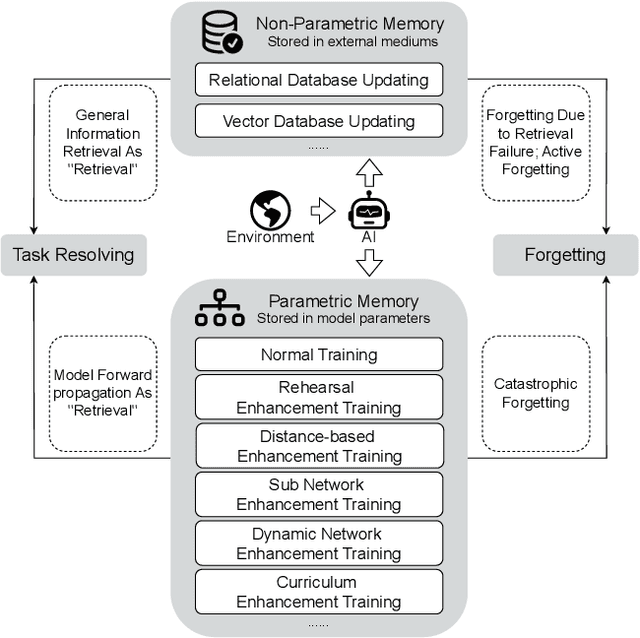
Abstract:With the rapid advancement of AI systems, their abilities to store, retrieve, and utilize information over the long term - referred to as long-term memory - have become increasingly significant. These capabilities are crucial for enhancing the performance of AI systems across a wide range of tasks. However, there is currently no comprehensive survey that systematically investigates AI's long-term memory capabilities, formulates a theoretical framework, and inspires the development of next-generation AI long-term memory systems. This paper begins by systematically introducing the mechanisms of human long-term memory, then explores AI long-term memory mechanisms, establishing a mapping between the two. Based on the mapping relationships identified, we extend the current cognitive architectures and propose the Cognitive Architecture of Self-Adaptive Long-term Memory (SALM). SALM provides a theoretical framework for the practice of AI long-term memory and holds potential for guiding the creation of next-generation long-term memory driven AI systems. Finally, we delve into the future directions and application prospects of AI long-term memory.
On Extending Direct Preference Optimization to Accommodate Ties
Sep 25, 2024



Abstract:We derive and investigate two DPO variants that explicitly model the possibility of declaring a tie in pair-wise comparisons. We replace the Bradley-Terry model in DPO with two well-known modeling extensions, by Rao and Kupper and by Davidson, that assign probability to ties as alternatives to clear preferences. Our experiments in neural machine translation and summarization show that explicitly labeled ties can be added to the datasets for these DPO variants without the degradation in task performance that is observed when the same tied pairs are presented to DPO. We find empirically that the inclusion of ties leads to stronger regularization with respect to the reference policy as measured by KL divergence, and we see this even for DPO in its original form. These findings motivate and enable the inclusion of tied pairs in preference optimization as opposed to simply discarding them.
Control-DAG: Constrained Decoding for Non-Autoregressive Directed Acyclic T5 using Weighted Finite State Automata
Apr 10, 2024



Abstract:The Directed Acyclic Transformer is a fast non-autoregressive (NAR) model that performs well in Neural Machine Translation. Two issues prevent its application to general Natural Language Generation (NLG) tasks: frequent Out-Of-Vocabulary (OOV) errors and the inability to faithfully generate entity names. We introduce Control-DAG, a constrained decoding algorithm for our Directed Acyclic T5 (DA-T5) model which offers lexical, vocabulary and length control. We show that Control-DAG significantly enhances DA-T5 on the Schema Guided Dialogue and the DART datasets, establishing strong NAR results for Task-Oriented Dialogue and Data-to-Text NLG.
Few-Shot VQA with Frozen LLMs: A Tale of Two Approaches
Mar 17, 2024Abstract:Two approaches have emerged to input images into large language models (LLMs). The first is to caption images into natural language. The second is to map image feature embeddings into the domain of the LLM and pass the mapped embeddings directly to the LLM. The majority of recent few-shot multimodal work reports performance using architectures that employ variations of one of these two approaches. But they overlook an important comparison between them. We design a controlled and focused experiment to compare these two approaches to few-shot visual question answering (VQA) with LLMs. Our findings indicate that for Flan-T5 XL, a 3B parameter LLM, connecting visual embeddings directly to the LLM embedding space does not guarantee improved performance over using image captions. In the zero-shot regime, we find using textual image captions is better. In the few-shot regimes, how the in-context examples are selected determines which is better.
PreFLMR: Scaling Up Fine-Grained Late-Interaction Multi-modal Retrievers
Feb 13, 2024Abstract:Large Multimodal Models (LMMs) excel in natural language and visual understanding but are challenged by exacting tasks such as Knowledge-based Visual Question Answering (KB-VQA) which involve the retrieval of relevant information from document collections to use in shaping answers to questions. We present an extensive training and evaluation framework, M2KR, for KB-VQA. M2KR contains a collection of vision and language tasks which we have incorporated into a single suite of benchmark tasks for training and evaluating general-purpose multi-modal retrievers. We use M2KR to develop PreFLMR, a pre-trained version of the recently developed Fine-grained Late-interaction Multi-modal Retriever (FLMR) approach to KB-VQA, and we report new state-of-the-art results across a range of tasks. We also present investigations into the scaling behaviors of PreFLMR intended to be useful in future developments in general-purpose multi-modal retrievers.
 Add to Chrome
Add to Chrome Add to Firefox
Add to Firefox Add to Edge
Add to Edge